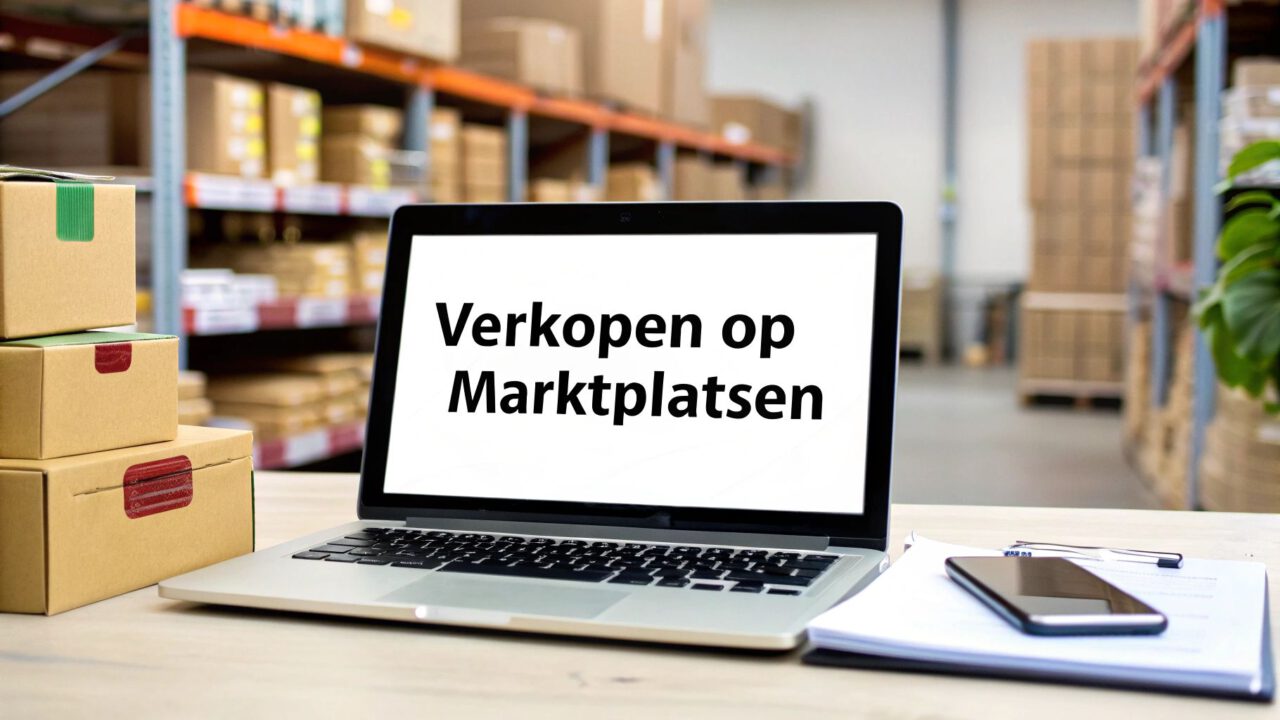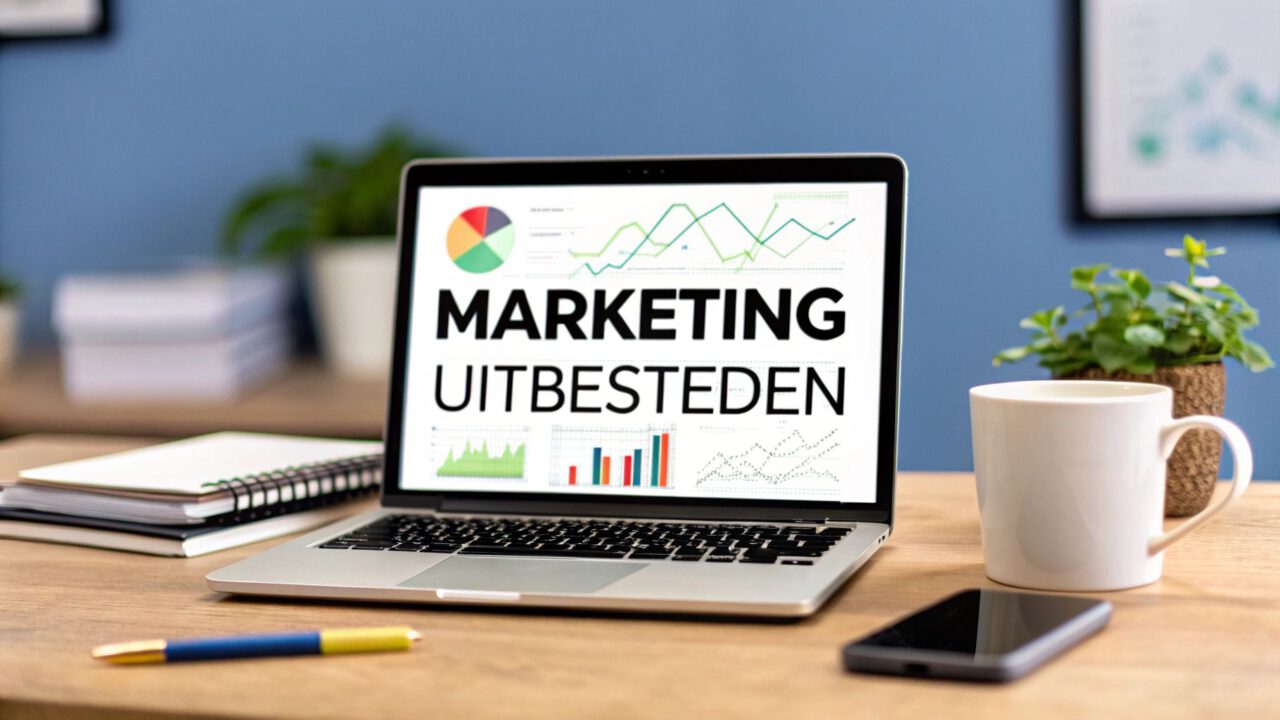The growth of e-commerce in Belgium is unstoppable. It's a market driven by a rock-solid digital infrastructure and growing consumer confidence in online shopping. There are enormous opportunities here for both startups and established companies, but the key to success often lies in smart partnerships. To be truly successful, it's essential to understand the local market and have the right partners at your side.
The Belgian e-commerce market deciphered
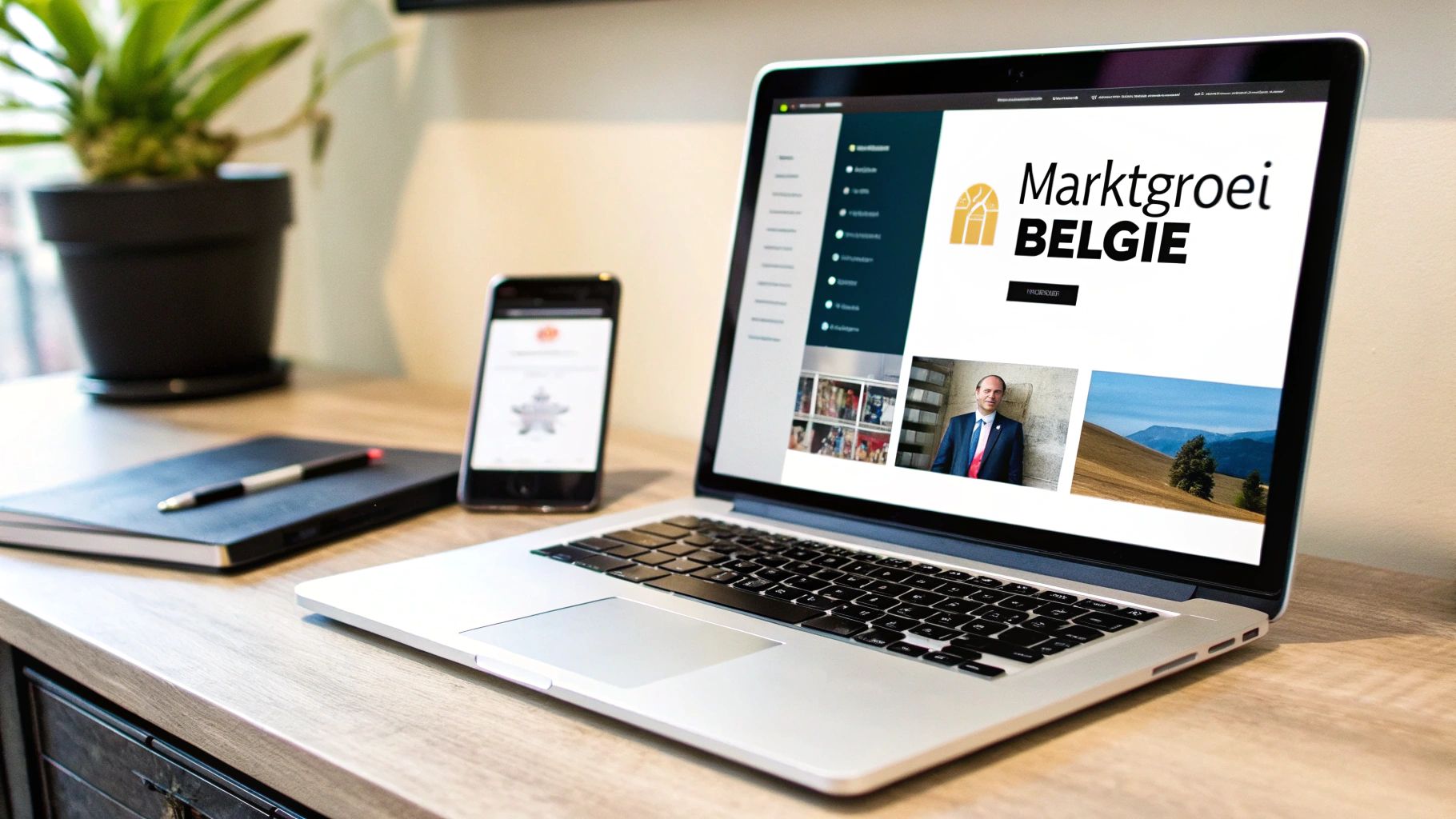
The Belgian e-commerce market is much more than just a collection of online stores. Think of it as a vibrant and dynamic ecosystem that's constantly evolving. If you're considering entering the market, it's crucial to first properly assess its size and potential. The figures show a market that's not only mature but also offers plenty of room for growth, especially for those who leverage the power of collaboration.
The driving force behind this growth? Simple: a combination of high internet penetration and a population that has fully embraced digital technologies. This creates the perfect breeding ground for online sales. Starting an online store in Belgium means targeting an audience accustomed to searching, comparing, and buying online.
Growth figures and market potential
The hard figures for the Belgian e-commerce market speak for themselves and all point in the same direction: upward. This isn't a temporary hype, but a fundamental shift in how consumers shop. The demand is no longer or Belgians buy online, but how and Where that is what they prefer to do.
Understanding market data is your first step toward a successful strategy. It not only tells you where the market stands today, but also provides a glimpse into the future: where the opportunities lie and how consumer preferences are evolving.
Let's make those numbers concrete. The forecast is that the Belgian e-commerce market will have a turnover of more than €24 billion will reach. That is a significant jump compared to the estimated €18 billion in 2024. This expansion is supported by an expected compound annual growth rate of approximately 5,6% until 2028. And what's even more interesting: the average Belgian online shopper spends approximately €2.600 out, one of the highest amounts in Europe. This indicates both frequent purchases and larger shopping carts. Want to dive deeper into the data? Then take a look at this essential facts about Belgian e-commerce on landmarkglobal.com.
What drives the Belgian online consumer?
Behind these impressive growth figures is an increasingly demanding and digitally oriented consumer. The growth of e-commerce in Belgium is fueled by a mix of societal and technological factors.
Some of the most important drivers at a glance:
- Exceptional digital connectivity: With an internet penetration of 94% and 96% Of the households with broadband access, online shopping is accessible to almost everyone. In both urban and rural areas, the digital shopping street is always open.
- The rise of mobile shopping: More than 58% of all online purchases in Belgium are made via a smartphone. A mobile-friendly webshop is no longer a nice-to-have; it's an absolute must for staying relevant.
- Changing consumer expectations: The modern shopper expects convenience, speed, and a personalized approach. This translates into a clear preference for fast delivery, a smooth returns process, and a seamless shopping experience, regardless of the device.
Together, these elements form the foundation of the Belgian e-commerce market. For you as an entrepreneur, this means that success depends on your ability to perfectly respond to these specific, local needs. In the following sections of this guide, we'll delve deeper into the practical steps, often in collaboration with the right partners, to establish a strong position in this promising market.
Your foundation for a successful Belgian webshop
Entering the Belgian e-commerce market with just a good idea isn't enough. To be truly successful, you need a rock-solid foundation. This foundation rests on three crucial pillars that not only determine your daily operations but also directly impact your customer experience.
Think of it like building a house. Without the proper permits (legal requirements), a secure and trusted front door (payment methods), and a reliable path to that door (logistics), no one will feel welcome. Getting these elements right from the start, often with the help of specialized partners, is the first step toward sustainable success.
The legal rules of the game in Belgium
Navigating the legal landscape is a crucial, and frankly, unavoidable, first step. Belgium has specific regulations that protect consumers and ensure a fair market. Ignoring these rules isn't an option: it could land you in fines and, perhaps even worse, significantly damage your customers' trust.
Pay particular attention to these key points:
- VAT regulations: Make sure your prices include the correct Belgian VAT and that you pay it correctly. Be crystal clear about this; it's not only legally required, but it also builds trust.
- Consumer rights: The Belgian consumer is excellently protected. This means, among other things, a right of withdrawal 14 days and clear warranty policies. Communicate these proactively and clearly on your website.
- Privacy legislation (GDPR): How you collect, store, and use customer data must be fully GDPR-compliant. No compromises here.
By following these rules from the start, you will build a reputation as a reliable, professional player. To help you through the first crucial stages, this step-by-step plan for starting a webshop an excellent guide.
The key to conversion: Belgian payment methods
Okay, the customer is convinced and wants to buy. Fantastic! But the payment process absolutely shouldn't become an obstacle. Belgian consumers have very clear preferences, and offering the right payment options makes the difference between a successful sale and an abandoned cart.
A smooth and intuitive checkout process isn't a bonus, it's essential. As soon as customers see their preferred payment method, they immediately feel safe and secure. That extra push significantly increases the likelihood of a purchase.
The undisputed king in Belgium? That is Bancontact, with a market share of more than 60% For online payments, not offering Bancontact is a rookie mistake you simply can't afford. Credit cards (Visa, Mastercard) and digital wallets like PayPal are also essential.
Here's an overview of the most popular payment methods, their estimated market share, and the key benefits for you as an entrepreneur.
Popular payment methods in Belgium compared
| Payment method | Market share (estimate) | Main advantage for web shops |
|---|---|---|
| Bancontact | > 60% | An absolute must-have. The most trusted and widely used payment method. |
| Credit card (Visa/Mastercard) | ~ 20% | Essential for international customers and larger purchases. |
| PayPal | ~ 10% | Offers purchase protection and is known worldwide. |
| Bank transfer | < 5% | Becoming less popular, but can be useful for B2B or specific niches. |
| Klarna (Pay Later) | Growing | Lowers the purchase threshold by allowing customers to pay later. |
By offering a smart mix, often through a payment provider that bundles these options, you ensure that almost every visitor finds a payment method they know and trust.
The image below shows what Belgian consumers prefer to shop for online.
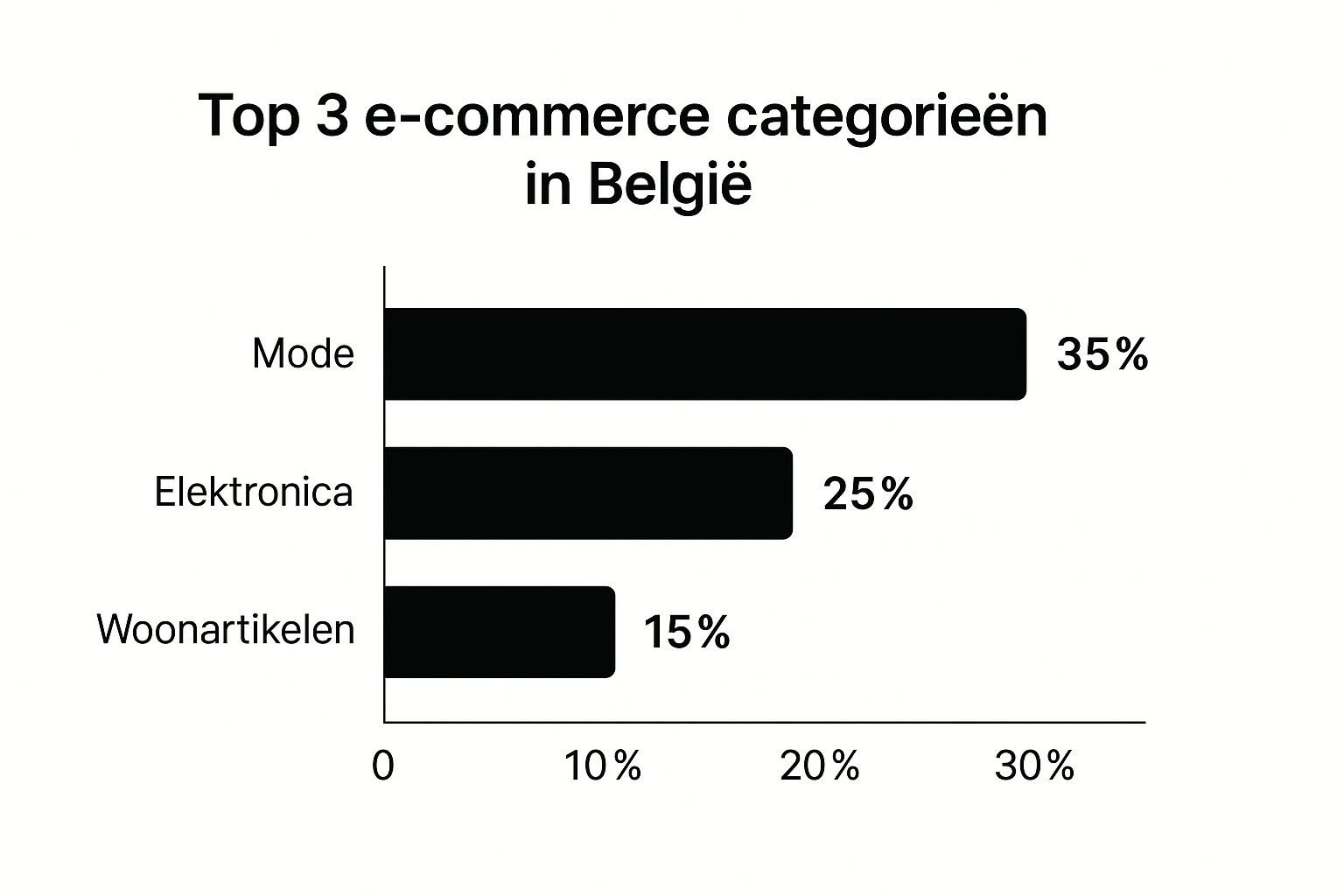
As you can see, fashion, electronics, and home furnishings are the largest segments. In these popular categories, a seamless checkout process is essential to stay ahead of the competition.
Logistics: the final step in the customer journey
Logistics is the final, and perhaps most important, point of contact with your customer. Smooth delivery can turn a one-time buyer into a loyal fan. Moreover, in a compact country like Belgium, expectations are high.
Flexibility is key here. In addition to traditional home delivery, collection points—think of the Bpost or PostNL networks—are incredibly popular. 40% of Belgian online shoppers regularly choose this option. It gives them control and convenience, two things that modern consumers greatly appreciate.
Also consider:
- Transparent shipping costs: Be clear about this from the start. Nobody likes surprises at checkout.
- Fast delivery times: “Ordered today, delivered tomorrow” is increasingly becoming the standard expectation.
- Simple return process: A clear and preferably free returns policy removes any last doubts a customer may have and lowers the threshold for purchasing.
Establishing these foundations takes time and money, that's true. But it's an investment that will pay for itself many times over. Curious about a realistic budget? Find out at https://expertmedia.be/een-volledige-webshop-kan-reeds-vanaf-1500-e/ what a professional webshop can cost.
The online purchasing behaviour of the Belgian consumer
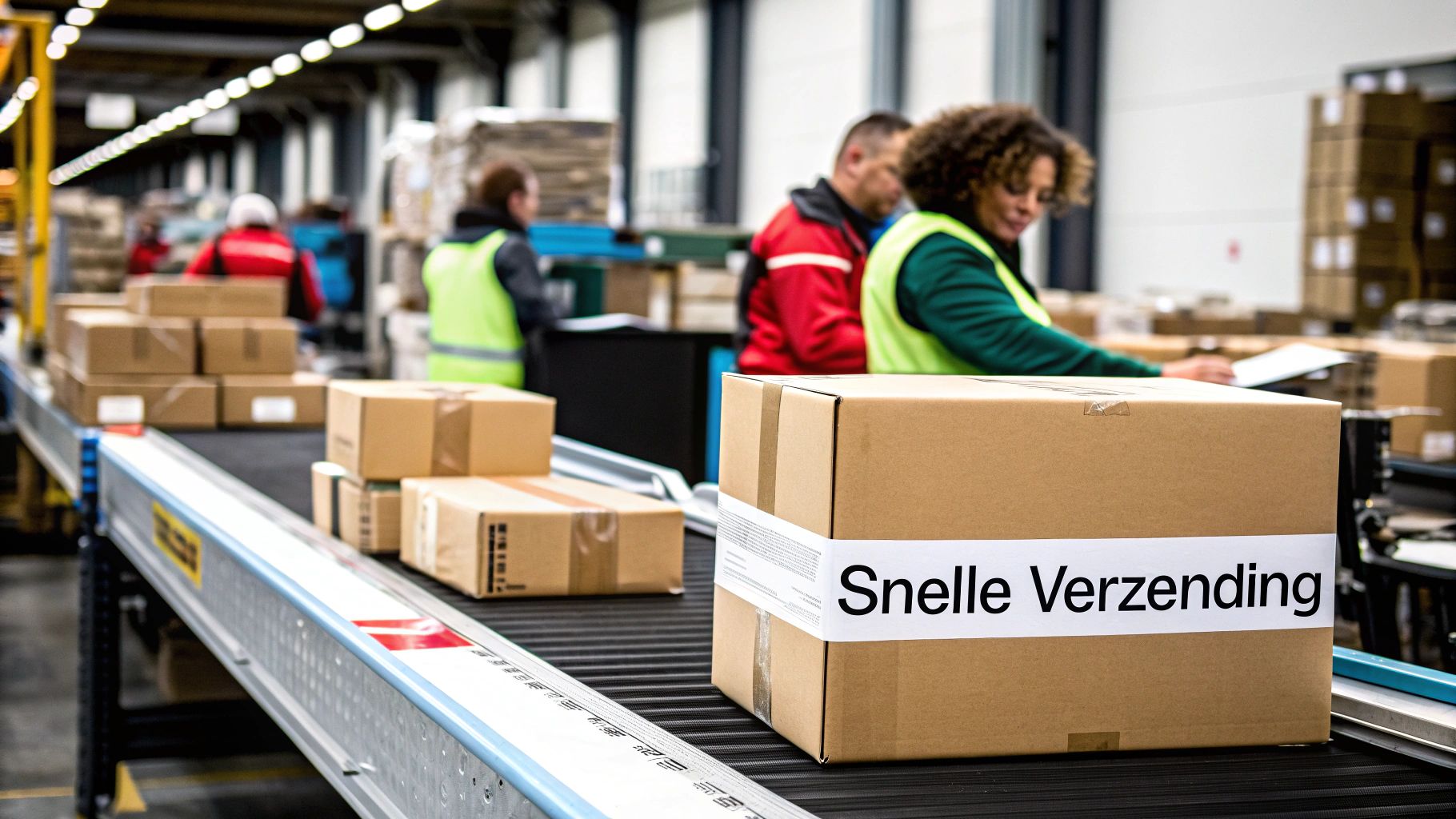
Who wants to achieve success with e-commerce in Belgium, must first understand the Belgian online shopper. The journey from casual visitor to satisfied, paying customer is a delicate one. As an entrepreneur, you can truly make a difference at crucial moments, but you need to know where those moments are. Understanding the figures is the first step.
The Belgian e-commerce market is very much alive. With a turnover estimated at around US$9.36 billion and stable growth is the potential is very clear. An interesting detail is the 'add-to-cart rate': in Belgium it fluctuates around 8,5% to 9,0%This means that a significant portion of your visitors actually has the intention to buy something. More Belgian market figures can be found at ecdb.com.
But there's a catch. That purchase intent doesn't always translate into a completed sale, and that's because of a notorious phenomenon: the abandoned shopping cart.
The big challenge: the abandoned shopping cart
A visitor fills their digital cart, clicks through to the checkout… and then clicks away. It's every webshop owner's nightmare. In Belgium, this is a harsh reality: the abandoned cart rate is around 66%. That means you lose two out of every three potential sales in the very last phase.
Imagine a physical store: a customer loads their cart, goes to the checkout, and simply leaves it there to leave the store. The reasons are varied, but they almost always point to unexpected obstacles in those final, crucial steps.
An abandoned cart isn't a sign of disinterest in your products. It's a signal that something's wrong with your checkout process. wild He wanted to buy it, but something was holding him back. Your task is to find and remove that barrier.
The most common reasons for abandonment are often surprisingly simple to solve. It all starts with empathy: see the process through your customer's eyes.
Practical tips to increase your conversion
Fortunately, that high percentage isn't a given. With a few targeted adjustments, you can drastically reduce this figure and convert more visitors into loyal customers. The focus is on creating a smooth and reliable experience.
Here are some concrete strategies you can implement right away:
- Be crystal clear about all costs: Unexpected shipping costs are the absolute number one reason for abandonment. Display all costs, including shipping and any applicable taxes, as early as possible. Even better? Consider free shipping over a certain amount to completely remove the barrier.
- Offer a guest checkout: Don't force customers to create an account. A long, mandatory registration form is a huge turn-off. Give them the option to checkout as a guest; speed and convenience always win.
- Think mobile, anytime, anywhere: A large proportion of Belgians shop on their smartphones. Your checkout process must therefore work perfectly on a small screen. Think large buttons, simple forms, and a clear layout.
- Show that you can be trusted: Prominently display payment method logos, security certificates (such as SSL), and any quality marks. This reassures customers that their data is secure.
By addressing these obstacles, you'll not only increase your conversion rate, but you'll also build stronger trust with your customers, laying the foundation for the next step: forging strategic partnerships to further accelerate your growth.
Smart partnerships: the key to faster growth
Conquering the Belgian e-commerce market? That's not a solo mission. Real growth almost always stems from smart partnerships. This goes much deeper than just choosing a supplier; it's about forging strategic alliances that leverage your business. Why reinvent the wheel when there are local experts who already know every corner of the road?
Think of these partnerships as the foundation of your entire operation. You're essentially building a dream team: you're the captain of the ship, but you surround yourself with specialists who each perfectly fit a crucial piece of the puzzle. This not only results in efficiency but, more importantly, ensures a customer experience that leaves your competitors in the dust.
The logistical backbone of your webshop
That last part of the journey, the last mile, is perhaps the most important point of contact with your customer. A perfect delivery can turn a one-time buyer into a loyal fan. Partnering with a local logistics powerhouse, such as Bpost or PostNL, is therefore not a luxury, but an absolute must for anyone who e-commerce in Belgium do.
These partners do much more than just deliver parcels from A to B. They know the local geography inside and out, understand what Belgian consumers expect, and offer precisely the flexibility customers crave.
- A network of collection points: They have a huge network of pickup points and parcel lockers. This gives customers the freedom to pick up their orders whenever and wherever they want. That freedom is invaluable.
- Reliability and speed: Local players have fully aligned their processes with the Belgian market. The result? Faster delivery times and reliability you can count on. This directly impacts your customer satisfaction.
- Simple returns: A smooth, local returns process removes a significant barrier to purchase. Customers are more likely to order when they know returns are hassle-free.
In short, these collaborations make your life easier and strengthen customer confidence in your brand.
The right partners for payments and marketing
A rock-solid alliance doesn't stop at logistics, of course. The partners you choose for your payment transactions and marketing are just as important. They form the bridge between your product and the wallet and the hearts of Belgian consumers.
A Belgian payment provider that seamlessly integrates Bancontact is simply non-negotiable. These providers not only understand the technology but also what local users expect in terms of security. This ensures a reliable and smooth checkout process, which drastically reduces shopping cart abandonment.
The right partner speaks not only your language, but also your customer's. They understand the cultural nuances, regional differences, and local consumer psychology that make the difference between a good and a great marketing campaign.
A local marketing agency is invaluable here. They know the media, the influencers, and the tone of voice in Flanders, Wallonia, and Brussels. They'll help you craft a message that feels authentic and relevant, giving your brand awareness and credibility a huge boost.
Building a lead together
The core message is actually quite simple: you don't have to do this alone. Strategic partnerships are the way to accelerate your growth in the Belgian e-commerce market. By joining forces with local experts, you create an ecosystem that is efficient, customer-focused, and razor-sharp.
Just think of the benefits:
- Get to market faster: You plug directly into the existing infrastructure and knowledge of your partners.
- More focus, less hassle: You can concentrate on what you are good at, while specialists take care of the operational side.
- A better customer experience: Local expertise in logistics, payments, and marketing creates a seamless and trusted experience for your customer.
Investing in these relationships doesn't always have to be your sole responsibility. Flemish entrepreneurs should know that certain advisory services and training courses, for example, for your digital marketing strategy, may be eligible for subsidies. Learn more about the subsidy options via the SME portfolio on expertmedia.be can help you to finance the expertise of partners smartly.
By forging the right alliances, you're not just building an online store. You're building a solid, future-proof e-commerce business.
Marketing and SEO tailored to the Belgian buyer
Okay, you have a great product and your online store is running smoothly. Fantastic, but that's just the beginning. The real challenge? Making sure Belgian consumers actually find you. And let's be honest, that's where a smart marketing and SEO approach, specifically for Belgium, makes the difference between a hobby project and a thriving business.
You can't simply generalize the Belgian market. We're a complex country, with diverse languages, cultures, and customs. A marketing campaign that works smoothly in Antwerp might be a complete failure in Liège. A localized strategy, ideally developed with a partner who understands the market, isn't a "nice to have," it's an absolute must.
Multilingualism: more than a translation
The golden rule for e-commerce in Belgium is actually quite simple: speak your customer's language. A webshop that's only available in Dutch or French automatically excludes half of your potential customers. Multilingualism isn't a technical bonus here; it's your most powerful marketing tool. It builds trust and immediately makes your shop much more accessible.
And we're not just talking about translating your product descriptions. Think about a complete, seamless experience:
- Content marketing: Offer your blogs, guides, or videos in both languages. A French-speaking customer will simply feel more connected to an article in their native language.
- Customer Service: Make sure you can answer questions in both Dutch and French. This is worth its weight in gold for your reputation.
- Automatic emails: From your order confirmation to your newsletter, everything must be sent out in the correct language.
By taking this seriously, you show respect for every customer. That small effort significantly lowers the barrier to purchase from you.
Regional SEO for a top position in Google
Once your multilingual foundation is in place, it's time to dive into Search Engine Optimization (SEO)Simply put: how do you ensure your online store appears at the top of Google when someone searches for what you sell? Here too, those typically Belgian differences play a crucial role.
SEO in Belgium can sometimes feel like playing on two chessboards at once. You not only need to know the right keywords, but also understand that a Flemish person searches differently than a Walloon. This requires separate keyword research for each language region.
For example, a Flemish person might type "buy running shoes," while a Walloon might search for "buy running shoes." These may seem like details, but they're essential for search engine ranking. Thorough keyword research by region is therefore the first step. Dive in: which terms are popular, what are your competitors doing, and where are the opportunities to seize? This is the foundation for all your texts and content. If you want to better understand the basic principles, this article will explain the difference between SEO and SEA on expertmedia.be in great detail.
Smart marketing at a local level
Besides a rock-solid online presence through SEO, there are numerous opportunities in local marketing that can give your brand awareness a serious boost. The key here is collaborating with Belgian partners. They know the market, the culture, and the people, which ensures an authentic and recognizable image.
For example, consider collaborating with local influencers. An influencer from Ghent will have a much greater impact on their local followers than a big international name. Such a recommendation feels personal and trustworthy, a perfect way to quickly build awareness among the right target audience.
Other ideas to score locally:
- Collaborate with other Belgian webshops: Do you sell coffee beans? Partner with a shop that offers coffee machines for a joint promotion.
- Show up at local events: Depending on your product, a booth at a local market or trade show can bring you into direct contact with your customers. Nothing is more powerful than a personal conversation.
- Advertise in regional media: Consider targeted advertising on local news websites or in magazines to get your name out there.
By combining a flawless multilingual website with regionally tailored SEO and smart local campaigns, you'll build a marketing strategy that truly works in Belgium. You'll demonstrate that you understand the market and are willing to go the extra mile – an investment that will undoubtedly pay off in loyal customers and sustainable growth.
A look into the future of e-commerce in Belgium

The Belgian e-commerce market is constantly evolving. Anyone who wants to be relevant today must already be thinking about tomorrow. It's not just about the latest gadgets, but above all about understanding how consumer expectations are changing and which technologies are responding to them.
A strategy built solely for the present has a short shelf life. The truly successful entrepreneurs are those who anticipate the questions their customers will ask tomorrow. This requires a flexible approach and the courage to innovate.
Sustainability is no longer an extra
Sustainability used to be a "nice to have," but today it's a deciding factor for many Belgian shoppers. Consumers want more than just a good product; they want to feel good about their purchase. They want to know their money is going to a company that takes its responsibility seriously.
And then they look beyond the product itself. The whole story has to be right:
- Packaging: Say goodbye to unnecessary plastic. Recycled or minimalist packaging is slowly becoming the norm.
- Transparent chain: Where does this product come from? Who made it? Customers appreciate honesty about the production process.
- Green delivery: Consider CO2-neutral delivery options or promoting collection points to reduce the logistics footprint.
By taking sustainability seriously, you not only improve your image but also appeal to a growing group of conscious consumers who are often willing to invest in brands that share their values.
AI, personalization and the power of social commerce
Technology is undoubtedly the driving force behind the next big leap in Belgian e-commerce. Two trends stand out: the smart use of Artificial Intelligence (AI) and the unstoppable rise of shopping via social media.
With AI, you can personalize the shopping experience like never before. Instead of showing everyone the same homepage, AI can perfectly tailor content and product recommendations to the browsing behavior of each unique visitor. This leads to greater engagement and, ultimately, higher conversion rates.
The future of online shopping is hyper-personalized. AI gives us the key to creating a unique, personalized experience for every customer. This is how you truly build a strong bond with your brand.
In addition, we see the boundaries between social media and web shops becoming increasingly blurred. Social commerce Selling directly through platforms like Instagram or Facebook is a game-changer. It drastically shortens the path from inspiration to purchase, because the customer doesn't even have to leave the platform.
Innovation through rapid digital adoption
Competition in Belgium is fierce, partly because local SMEs haven't missed the digital train. Compared to the rest of Europe, Belgian companies are remarkably active in e-commerce. More than 27% of Belgian SMEs generate at least 1% of their turnover from online sales, which is much higher than the European average 19,1%This proactive attitude creates a vibrant, innovative market. It immediately raises the bar considerably for those who want to get in today. Want to know more? Detailed figures about the You can find the digital achievements of Belgian SMEs on maes-media.be.
Together, these trends will shape tomorrow's playing field. Those who capitalize on them will build a resilient business that not only succeeds today but is also ready for the opportunities that lie ahead.
Frequently asked questions about e-commerce in Belgium
Anyone planning to start an online store in Belgium—or expand an existing one here—often has a lot of questions. And that's understandable. To help you get started, we've compiled the most frequently asked questions below, with clear and practical answers.
What are the biggest challenges?
Logistics in such a densely populated country can be a real challenge. That's often the first hurdle. But the biggest hurdle is multilingualism. There's simply no getting around it: your online store and customer service must work flawlessly in both Dutch and French. Otherwise, you're missing out on half the market.
Moreover, competition is fierce. To gain the trust of Belgian consumers, you also have to ensure they can pay in their usual way. Bancontact is absolutely indispensable.
Which products perform best online?
Traditionally speaking, scoring fashion and clothing extremely good, immediately followed by electronics and stuff for house and gardenWhat we have seen in recent years is a serious increase in online sales of food and groceries.
As tempting as general trends may be, don't blindly follow them. Always thoroughly research your specific niche. What works for the masses isn't automatically the golden formula for your unique offering.
Do I need a Belgian company to sell here?
No, that's not strictly necessary. You can perfectly deliver to Belgian customers from another EU country. The European internal market makes that relatively simple.
What you do need to be very aware of is the law. You must comply with all Belgian and European regulations. This includes VAT rules for distance selling and consumer rights, such as the statutory return period. 14 daysA sound legal basis is truly the foundation for long-term success.
Ready to conquer the Belgian market? At Expert media We don't just build webshops; we work with you to build a sales engine with a marketing strategy that delivers results. Contact us today at our website and discover how we can accelerate your online growth.


